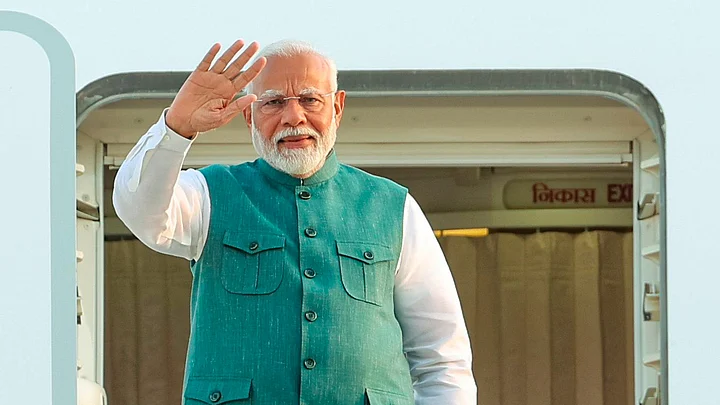The author has no hesitation in admitting that he is no political pundit, unlike many analysts who do post-election postmortems faster than a seasoned pathologist. But some things are obvious to even amateur students of politics like me.
Two things stand out in the overcrowded field of analysis. One, how does one describe this regime, i.e., "Modi 3.0"? That is a nomenclature quibble and of not much significance.
The second one is far more important. Will this regime have its full term of five years or are we going to see a repeat of 1999 when the then Prime Minister Atal Bihari Vajpayee lost a vote of confidence?
Who has been made a minister and who has wrangled what portfolio, in that context, is just fleeting news.
Let’s look at the nomenclature.
Virtually every media platform — print, electronic, and digital — is describing this regime as Modi 3.0. Technically, they are right. After all, Narendra Modi has become prime minister for the third consecutive time.
But that description also camouflages reality. Look back at the 2024 Lok Sabha campaign.
In every rally and virtually every speech, Narendra Modi made the elections a referendum on himself. There was an incessant drumbeat of the BJP winning 370 seats and the NDA crossing 400. If you go by numbers, the referendum has been a mixed one for Modi.
On the plus side, it is remarkable for an incumbent who has ruled continuously for 10 years to lead his party to 240 seats in the Lok Sabha, two and half times the tally of its rival, i.e., the Congress party. Yet, there is also a reality check.
This is not purely a Modi victory. Without N Chandra Babu Naidu and Nitish Kumar, Modi could well have missed his third oath-taking. It’s a quibble, yes, but I would prefer to describe this regime not as Modi 3.0 but as NDA 5.0. It is a matter of perception, and perceptions play a huge role in politics.
The next war for perceptions will be witnessed in October 2024. The INDIA bloc partners and some habitual Modi critics have started predicting the imminent demise of the government. They cite differences over ministerial berths and portfolio allocations as the first signs of a collapsing regime.
That’s a childish analysis. The regime is safe. At least till October, when Rohtak, Ranchi, and Raigad come into play. After that, all bets are off and anything can happen.
Why Rohtak, Ranchi, and Raigad? Quite simple, really.
Assembly elections are due around October 2024 in Haryana, Jharkhand, and the all-important Maharashtra. To re-emphasise, politics is about perceptions. So, when Narendra Modi starts his third term with Rajnath Singh, Amit Shah, Nirmala Sitharaman and S Jaishankar with the same portfolios, there is a strong perception about both continuity and stability.
But perceptions can change quickly. More importantly, political actors are usually smarter than analysts in correcting and gauging the shift in perceptions. They also act accordingly. How voters act in these assembly elections will determine to a large extent how the NDA alliance partners like the TDP, the JD(U), the LJP, and the JD(S) play their cards.
Given how the overwhelming majority of analysts failed to read the undercurrent against the BJP in Uttar Pradesh (this one state cost the BJP a majority), it would be silly to make overconfident assertions of which way the assembly election results will go.
Yet, one can assess the probabilities based on ground realities and the performance of rival parties during the 2024 Lok Sabha elections.
Haryana first. Rohtak is symbolic of the resurgence of the Congress party in Haryana after almost 10 years of BJP rule. It has always been a Congress stronghold and is home to two-time Chief Minister Bhupinder Singh Hooda.
His son Deepender Hooda has just won the Rohtak Lok Sabha seat with a vote share of 63 percent. One feels a palpable sense of double-engine anti-incumbency against the BJP after 10 years. The reasons are many, and there is no space here to go into details.
But it would be fair to say that the Congress looks all set to storm back to power in Haryana and the BJP is all set to lose.
Jharkhand has its own unique polity. There were multiple unstable governments between the years 2000 (when the state was formed) and 2014. Since then, a BJP-led alliance ruled for five years and a JMM-led alliance is the incumbent.
The erstwhile Chief Minister Hemant Soren is in jail on money laundering charges. It would be fair to say that the opposing alliances are evenly matched.
That brings us to the critical state of Maharashtra with 48 MPs and 294 MLAs. The Lok Sabha results have come as a shock to the BJP whose tally crashed from 23 to just nine. Its alliance partners have not performed very well either. In contrast, the MVA alliance looks very upbeat and confident.
The perception too seems to favour the MVA. Both alliances will have serious issues when it comes to seat sharing. Besides, the BJP is known for learning lessons from reverses and coming back stronger. Yet, I would say it is the MVA at an advantage in Maharashtra.
If the BJP loses all three states, there will be many consequences for the party and the top leadership. The most important will be a significant growth in the perception that Brand Modi no longer shines as brightly.
What would Chandrababu Naidu and Nitish Kumar do then? There are interesting times ahead.
(Sutanu Guru is the Executive Director of the CVoter Foundation. This is an opinion article and the views expressed above are the author’s own. The Quint neither endorses nor is responsible for them.)
(At The Quint, we question everything. Play an active role in shaping our journalism by becoming a member today.)
